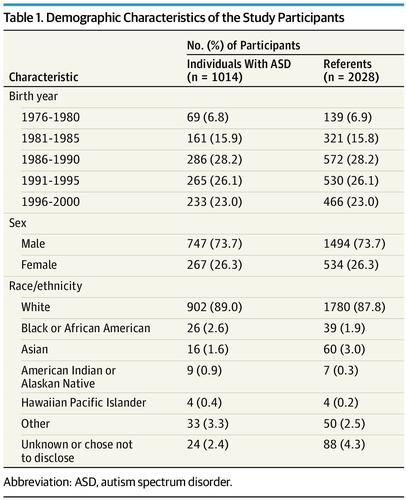当前位置:
X-MOL 学术
›
JAMA Pediatr.
›
论文详情
Our official English website, www.x-mol.net, welcomes your
feedback! (Note: you will need to create a separate account there.)
Association of Comorbid Mood and Anxiety Disorders With Autism Spectrum Disorder
JAMA Pediatrics ( IF 24.7 ) Pub Date : 2020-01-01 , DOI: 10.1001/jamapediatrics.2019.4368 Alexandra C Kirsch 1 , Andrea R S Huebner 1, 2 , Sunil Q Mehta 1, 2 , Flora R Howie 2 , Amy L Weaver 3 , Scott M Myers 4 , Robert G Voigt 5 , Slavica K Katusic 3
JAMA Pediatrics ( IF 24.7 ) Pub Date : 2020-01-01 , DOI: 10.1001/jamapediatrics.2019.4368 Alexandra C Kirsch 1 , Andrea R S Huebner 1, 2 , Sunil Q Mehta 1, 2 , Flora R Howie 2 , Amy L Weaver 3 , Scott M Myers 4 , Robert G Voigt 5 , Slavica K Katusic 3
Affiliation

|
Importance
It is critical to evaluate the risk of comorbid psychiatric diagnoses to meet the needs of individuals with autism spectrum disorder (ASD). Objective
To examine whether individuals with ASD are at greater risk for comorbid diagnoses of depression, anxiety, or bipolar disorder. Design, Setting, and Participants
This cohort study used data from a population-based birth cohort of 31 220 individuals born in Olmsted County, Minnesota, from January 1, 1976, to December 31, 2000. Patients with research-identified ASD were previously identified using a multistep process that evaluated signs and symptoms abstracted from medical and educational records. For each of the 1014 patients with ASD, 2 age- and sex-matched referents who did not meet criteria for ASD were randomly selected from the birth cohort (n = 2028). Diagnosis codes for anxiety, depression, and bipolar disorders were electronically obtained using the Rochester Epidemiological Project records-linkage system. Data analysis was performed from July 1, 2018, to April 1, 2019. Main Outcomes and Measures
Cumulative incidence of clinically diagnosed depression, anxiety, and bipolar disorder through early adulthood in individuals with ASD compared with referents. Results
A total of 1014 patients with ASD (median age at last follow-up, 22.8 years [interquartile range, 18.4-28.0 years]; 747 [73.7%] male; 902 [89.0%] white) and 2028 referents (median age at last follow-up, 22.4 years [interquartile range, 18.8-26.2 years]; 1494 [73.7%] male; 1780 [87.8%] white) participated in the study. Patients with ASD were significantly more likely to have clinically diagnosed bipolar disorder (hazard ratio [HR], 9.34; 95% CI, 4.57-19.06), depression (HR, 2.81; 95% CI, 2.45-3.22), and anxiety (HR, 3.45; 95% CI, 2.96-4.01) compared with referents. Among individuals with ASD, the estimates of cumulative incidence by 30 years of age were 7.3% (95% CI, 4.8%-9.7%) for bipolar disorder, 54.1% (95% CI, 49.8%-58.0%) for depression, and 50.0% (95% CI, 46.0%-53.7%) for anxiety. Among referents, cumulative incidence estimates by 30 years of age were 0.9% (95% CI, 0.1%-1.7%) for bipolar disorder, 28.9% (95% CI, 25.7%-32.0%) for depression, and 22.2% (95% CI, 19.3%-25.0%) for anxiety. Conclusions and Relevance
The findings suggest that individuals with ASD may be at increased risk for clinically diagnosed depression, anxiety, and bipolar disorder compared with age- and sex-matched referents. This study supports the importance of early, ongoing surveillance and targeted treatments to address the psychiatric needs of individuals with ASD.
中文翻译:

共病情绪和焦虑症与自闭症谱系障碍的关联
重要性 评估共病精神疾病诊断的风险对于满足自闭症谱系障碍 (ASD) 患者的需求至关重要。目的 检查患有自闭症谱系障碍 (ASD) 的个体是否更有可能同时诊断出抑郁症、焦虑症或双相情感障碍。设计、背景和参与者 这项队列研究使用了 1976 年 1 月 1 日至 2000 年 12 月 31 日期间出生于明尼苏达州奥姆斯特德县的 31 220 名个体的出生队列数据。研究确定的自闭症谱系障碍 (ASD) 患者之前已被识别使用多步骤过程评估从医疗和教育记录中提取的体征和症状。对于 1014 名 ASD 患者中的每一位,从出生队列中随机选择 2 名年龄和性别匹配但不符合 ASD 标准的参考对象 (n = 2028)。使用罗切斯特流行病学项目记录链接系统以电子方式获得焦虑、抑郁和双相情感障碍的诊断代码。数据分析于 2018 年 7 月 1 日至 2019 年 4 月 1 日期间进行。 主要结果和措施 与参考对象相比,自闭症谱系障碍患者在成年早期临床诊断的抑郁症、焦虑症和双相情感障碍的累积发生率。结果 共有 1014 名 ASD 患者(最后一次随访时的中位年龄为 22.8 岁[四分位数范围,18.4-28.0 岁];747 名[73.7%] 男性;902 名[89.0%] 白人)和 2028 名参考对象(中位年龄为 22.8 岁)最后一次随访,22.4 年[四分位数范围,18.8-26.2 岁];1494 名(73.7%)男性;1780 名(87.8%)白人)参与了该研究。自闭症谱系障碍患者明显更有可能患有临床诊断的双相情感障碍(风险比 [HR],9.34;95% CI,4.57-19.06)、抑郁症(HR,2.81;95% CI,2.45-3.22)和焦虑症(HR,2.81;95% CI,2.45-3.22)。 ,3.45;95% CI,2.96-4。01) 与参照物比较。在自闭症谱系障碍患者中,30 岁时,双相情感障碍的累积发病率为 7.3%(95% CI,4.8%-9.7%),抑郁症的累积发病率为 54.1%(95% CI,49.8%-58.0%), 50.0% (95% CI, 46.0%-53.7%) 焦虑。在参考对象中,30 岁时双相情感障碍的累积发病率估计为 0.9%(95% CI,0.1%-1.7%),抑郁症为 28.9%(95% CI,25.7%-32.0%),抑郁症为 22.2%(95 % CI, 19.3%-25.0%) 焦虑。结论和相关性 研究结果表明,与年龄和性别匹配的参考对象相比,自闭症谱系障碍患者患临床诊断的抑郁症、焦虑症和双相情感障碍的风险可能更高。这项研究支持了早期、持续监测和有针对性的治疗对于满足自闭症谱系障碍患者的精神需求的重要性。
更新日期:2020-01-01
中文翻译:

共病情绪和焦虑症与自闭症谱系障碍的关联
重要性 评估共病精神疾病诊断的风险对于满足自闭症谱系障碍 (ASD) 患者的需求至关重要。目的 检查患有自闭症谱系障碍 (ASD) 的个体是否更有可能同时诊断出抑郁症、焦虑症或双相情感障碍。设计、背景和参与者 这项队列研究使用了 1976 年 1 月 1 日至 2000 年 12 月 31 日期间出生于明尼苏达州奥姆斯特德县的 31 220 名个体的出生队列数据。研究确定的自闭症谱系障碍 (ASD) 患者之前已被识别使用多步骤过程评估从医疗和教育记录中提取的体征和症状。对于 1014 名 ASD 患者中的每一位,从出生队列中随机选择 2 名年龄和性别匹配但不符合 ASD 标准的参考对象 (n = 2028)。使用罗切斯特流行病学项目记录链接系统以电子方式获得焦虑、抑郁和双相情感障碍的诊断代码。数据分析于 2018 年 7 月 1 日至 2019 年 4 月 1 日期间进行。 主要结果和措施 与参考对象相比,自闭症谱系障碍患者在成年早期临床诊断的抑郁症、焦虑症和双相情感障碍的累积发生率。结果 共有 1014 名 ASD 患者(最后一次随访时的中位年龄为 22.8 岁[四分位数范围,18.4-28.0 岁];747 名[73.7%] 男性;902 名[89.0%] 白人)和 2028 名参考对象(中位年龄为 22.8 岁)最后一次随访,22.4 年[四分位数范围,18.8-26.2 岁];1494 名(73.7%)男性;1780 名(87.8%)白人)参与了该研究。自闭症谱系障碍患者明显更有可能患有临床诊断的双相情感障碍(风险比 [HR],9.34;95% CI,4.57-19.06)、抑郁症(HR,2.81;95% CI,2.45-3.22)和焦虑症(HR,2.81;95% CI,2.45-3.22)。 ,3.45;95% CI,2.96-4。01) 与参照物比较。在自闭症谱系障碍患者中,30 岁时,双相情感障碍的累积发病率为 7.3%(95% CI,4.8%-9.7%),抑郁症的累积发病率为 54.1%(95% CI,49.8%-58.0%), 50.0% (95% CI, 46.0%-53.7%) 焦虑。在参考对象中,30 岁时双相情感障碍的累积发病率估计为 0.9%(95% CI,0.1%-1.7%),抑郁症为 28.9%(95% CI,25.7%-32.0%),抑郁症为 22.2%(95 % CI, 19.3%-25.0%) 焦虑。结论和相关性 研究结果表明,与年龄和性别匹配的参考对象相比,自闭症谱系障碍患者患临床诊断的抑郁症、焦虑症和双相情感障碍的风险可能更高。这项研究支持了早期、持续监测和有针对性的治疗对于满足自闭症谱系障碍患者的精神需求的重要性。











































 京公网安备 11010802027423号
京公网安备 11010802027423号